
Rediscovering Japan

Rediscovering Japan
Travel (Iwate Part 3 (Hiraizumi))

by tomizuta
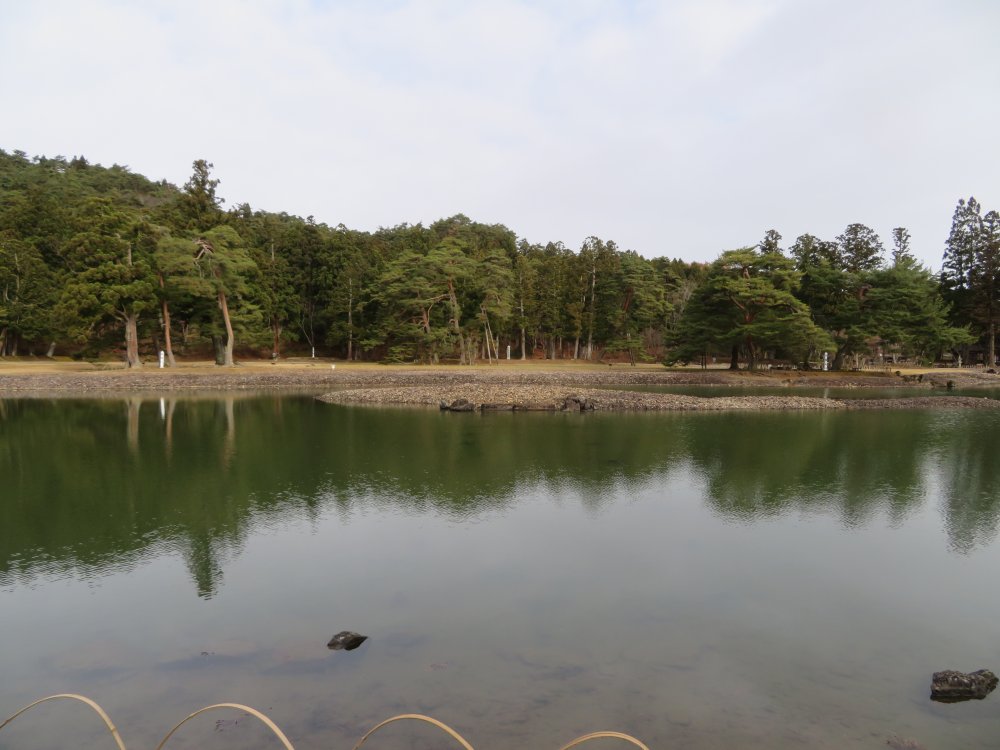
View of the paradise garden of Motsu-ji Temple from the ruins of the Nandai-mon (south gate) which served as the entrance gate to Hiraizumi in the 12th century. The Yakushiji Temple stood on the opposite side, and the island inbetween was to support the bridges from Nandaimon to Yakushiji Temple.h are usually stored in storehouses located across the township, four are displayed at the Exhibit Hall on a rotating basis.
In early December 2023, I revisited Hiraizumi for the first time in over 40 years. Iwate is the second largest prefecture in Japan. I had visited many parts in the central and northern area of the prefecture, but did not have the opportunity to visit Hiraizumi since I startied my homepage in 2016. Hiraizumi was designated as a World Heritage site in 2011. The description of the property on UNESCO’s website (https://whc.unesco.org/en/list/1277/) states “Hiraizumi - Temples, Gardens and Archaeological Sites Representing the Buddhist Pure Land comprises five sites, including the sacred Mount Kinkeisan. It features vestiges of government offices dating from the 11th and 12th centuries when Hiraizumi was the administrative centre of the northern realm of Japan and rivalled Kyoto. The realm was based on the cosmology of Pure Land Buddhism, which spread to Japan in the 8th century. It represented the pure land of Buddha that people aspire to after death, as well as peace of mind in this life. In combination with indigenous Japanese nature worship and Shintoism, Pure Land Buddhism developed a concept of planning and garden design that was unique to Japan.” As a certified guide I often take visitors to Japanese gardens, and explain the history and styles of Japanese gardens, of which paradise gardens is one major style. One focus of my visit on this occasion was to reinforce my understanding of paradise gardens. As usual, I started my visit with a visit to two museums to gain some insight on the property I was going to reexplore. I first visited the Hiraizumi Culture and History Museum.
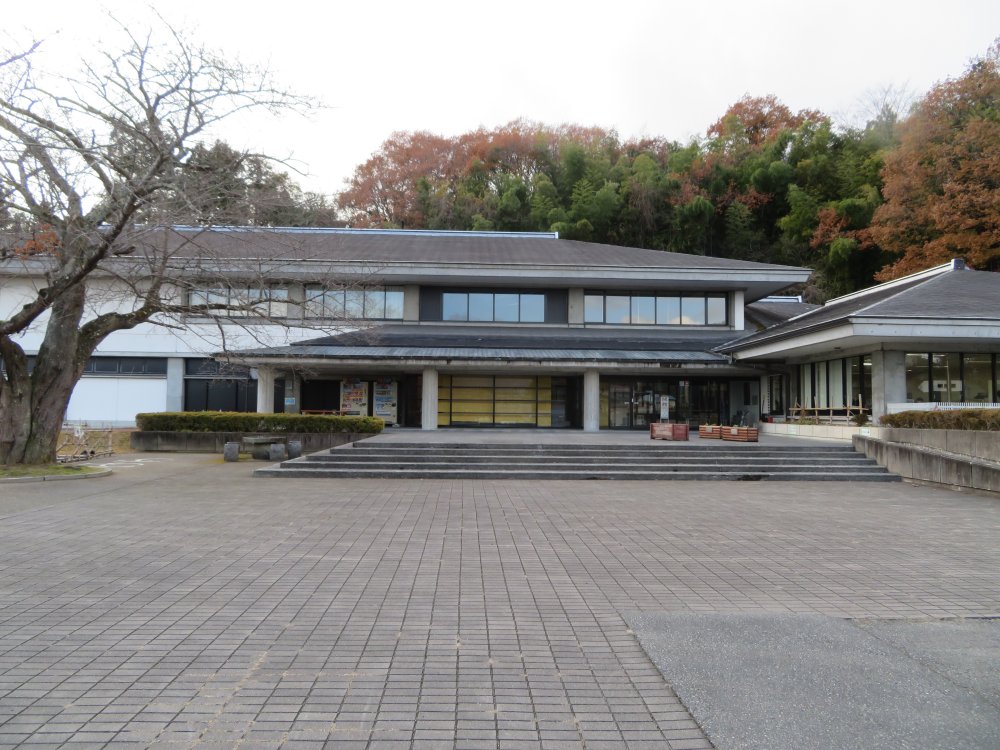
I first the Hiraizumi Culture and History Museum. This turned out to be a very informative visit to refresh my understanding of Hiraizumi’s heritage.
This turned out to be a very informative visit to refresh my understanding
of Hiraizumi’s heritage. Although perhaps a bit hard to follow for non-Japanese
visitors, the museum provides much information on the Fujiwara Family that
governed the entire Tohoku area for about 100 years. The Fujiwara Family
were purported to be descendants of a prominent court figure in the 7th
century, Kamatari Fujiwara. In the 12th century, several generations after
Kamatari, the Fujiwara Family in the Tohoku region were the samurai governing
the region from roughly Fukushima Prefecture in the south to Aomori Prefecture
in the north. Their reign started from Kiyohira Fujiwara and lasted for
four generations until the late 12th century, when they were defeated by
Yoritomo Minamoto, who became the first shogun and established his military
government in Kamakura, Kanagawa Prefecture. What visitors should keep
in mind when visiting Hiraizumi are that (i) the Fujiwara Family were one
of the prominent samurai groups that were active during the fight among
samurai clans to become the champion of the samurai warriors (ii) it was
the Genji clan that won the battle with the Heiji clan to ultimately become
the first samurai to be designated as Seii-taishougun (meaning “Shogun
in charge of the East”) empowered by the Emperor to govern Japan, (iii)
the four generations were Kiyohira, Motohira, Hidehira and Yasuhira, and
(iv) that the dream of the Fujiwara Family was to create a Buddhism paradise
in Hiraizumi, supported by the gold mined from the region. Visitors should
be able to gain much information of Hiraizumi’s heritage by visiting this
museum beforehand.
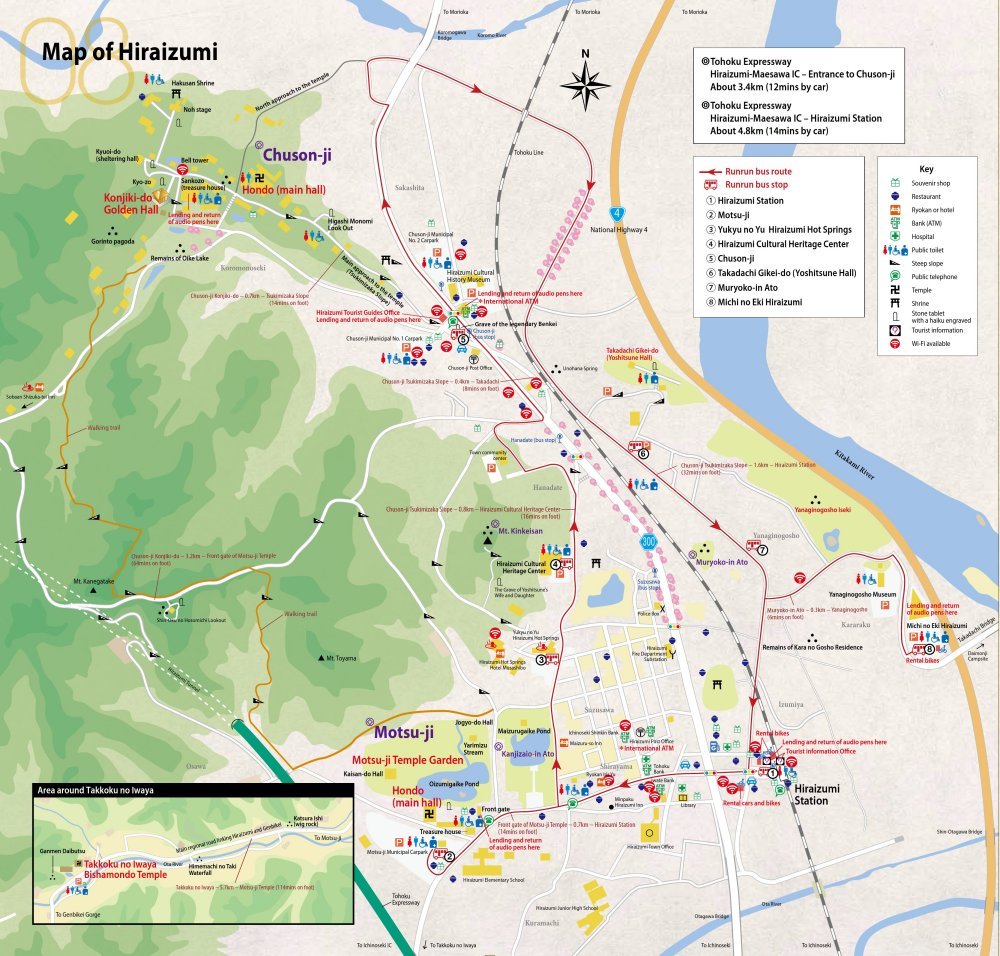
A map extracted from Hiraizumi Town's English brochure available at https://hiraizumi.or.jp/info/pdf/hiraizumi_sekaiisan_en.pdf. I believe the map will be helpful for readers to understand how I traveled around Hiraizumi Town.
I next visited the Hiraizumi World Heritage Information Center. Although the video featuring the Buddhist Pure Land which is the theme of Hiraizumi’s heritage is slightly interesting, I must confess I was quite disappointed with their displays, when compared with other World Heritage Information Centers such as at Stonehenge in the UK, or Iwami Silver Mines in Japan. I had booked a local guide to help me rediscover Hiraizumi. Before going any further, I think it will be beneficial to provide an explanation of the main places that constitute the World Heritage properties in Hiraizumi and where they are located.
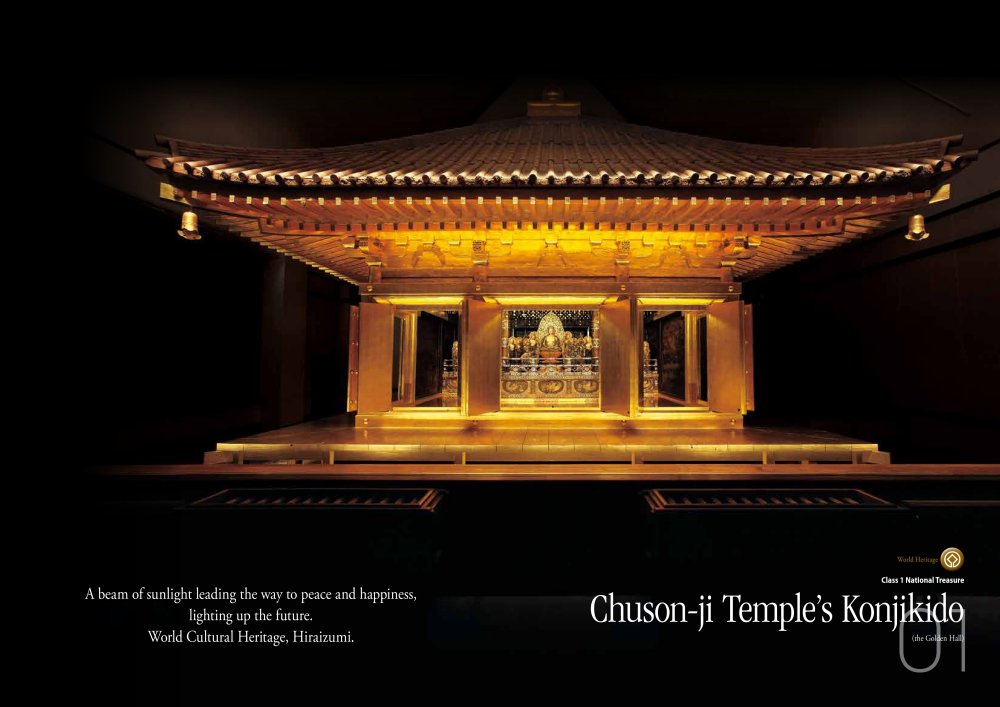
Picture of Chusonji's Konjikido extracted from Hiraizumi Town's English brochure available at https://hiraizumi.or.jp/info/pdf/hiraizumi_sekaiisan_en.pdf, as you are not allowed to take any pictures inside the Konjikido (Golden Temple).
One theme underpinning the World Heritage components is the notion of Buddhism Pure Land (Jodo) and the Japanese garden and temple complex depicting this notion. From this viewpoint, there are four such properties, which I introduce below in the order that they were constructed. 1. Chuson-ji Temple: Founded in the 9th century by the Buddhist high priest Ennin, Kiyohira, the founder of the Fujiwara Family that governed the Tohoku region for a century expanded the temple into a massive complex in the early 12th century, to mourn for the spirits of those killed in the bitter war ultimately leading to his victory, as well as to pray for a peaceful feudal land based on Buddhism. Chuson-ji does not have a paradise garden, but instead houses the Konjikido (Golden Temple) which is designated as a national treasure. 2. Motsu-ji Temple: Also founded by Ennin, the temple was expanded during the reign of the second and third lords, Motohira and Hidehira, Kiyohira’s son and grandson. Motsu-ji houses the grandest paradise garden, but most of the temple buildings have been lost in fire. 3. Kanjizaio-in Ato: The temple and garden were constructed by Motohira’s wife probably in the mid-12th century after Motohira’s death. Located adjacent to Motsu-ji, the temple has been lost and only the paradise garden has been resurrected. 4. Muryoko-in Temple Ruins: The temple and garden were constructed by Hidehira to replicate Uji-Byodo-in in Kyoto Prefecture. The temple was lost in fire and the gardens are at the final stages of restoration.
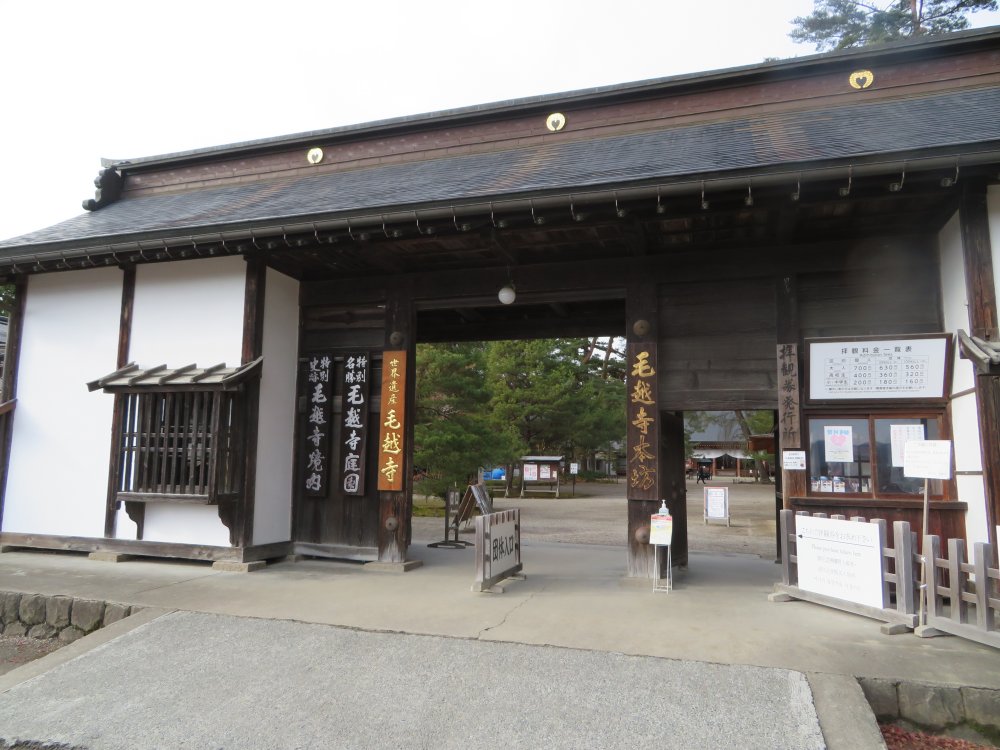
The admission office of Motsu-ji Temple. The entrance gate boasts the triple designation of World Heritage and the Special Historic Site and Special Place of
Scenic Beauty from Japan's Agency for Cultural Affairs.
I met up with our guide at the parking lot of Motsu-ji Temple. I paid the admission fee of 700 yen at the grand temple entrance gate. She first guided us to where a grand gate must have once stood leading to the bridge across the pond. The grand gate was called Nandaimon, meaning the grand south gate. Paradise gardens are designed to house the sacred statue of a Buddhism figure in a building on the opposite side of the pond. The opposite side of the pond was believed to be the Pure Land (Jodo). Typically, the sacred statue would be that of Amida Nyorai, believed to help common folk reach paradise. In Motsu-ji temple’s case, this was a Yakushi Nyorai, a benevolent figure that would heal all wounds, perhaps because Motohira wished for peace in the region. Do not miss the picture of the reconstructed temple complex and garden by the grand gate remains. Keep the picture in mind as you explore the temple complex ruins and garden, which gives you an inkling of how grand the temple must have been in its heydays, even grander than Chusonji expanded by Kiyohira, the founder of the Fujiwara Family.
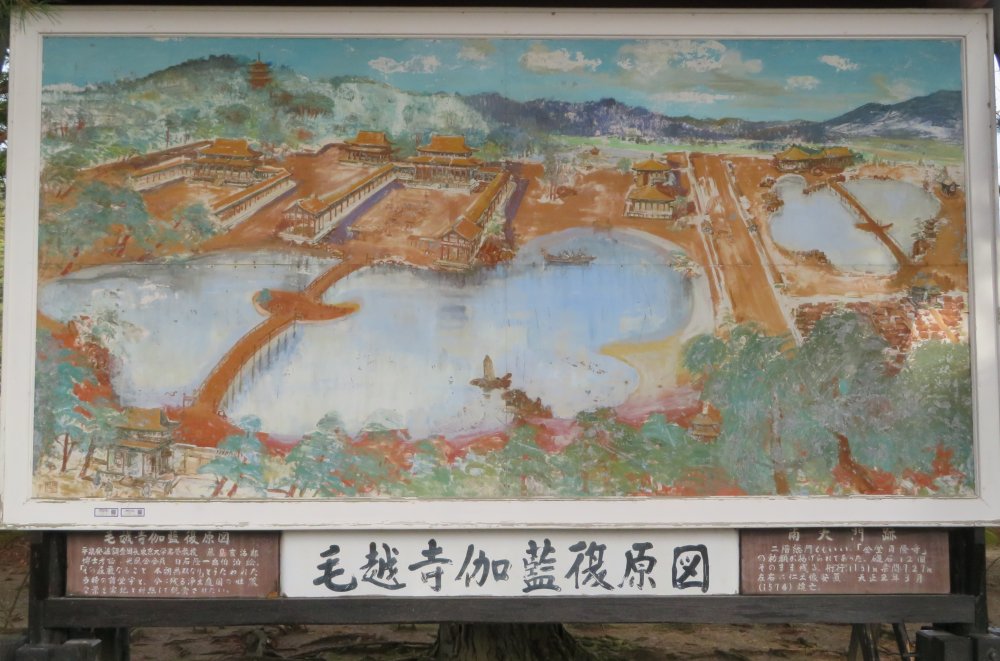
Reconstructed image of Motsu-ji Temple complex and gardens displayed by the ruins of Nandaimon. The Nandaimon Gate is on the bottom left. The Japanese explanation of Nandaimon on the bottome right tells "The Nandaimon was a two story entrance gate displaying the name Kondo Enryu-ji. Its 12 foundation stones have remained. The gate had a width of 11.5 meters and depth of 12.7 meters.
We then went to walk around the pond clockwise. We were shown the main temple buildings one by one. Only the foundations remain of the main buildings. We passed by one active building the Kaizando, commemorating the founder of Motsu-ji. The next to visit was Kasho-ji Temple which sat to the left of the main temple building. I understand archaeological evidence suggests that the temple can be dated back to the 9th century, much earlier than the main building. Judging from the foundation as well as the reconstructed image, Kasho-ji must have been as grand as the main temple building. This was followed by a visit to the site of the main temple building, Kondo Enryu-ji, which housed a 4.8 meters tall statue of Yakushi Nyorai.
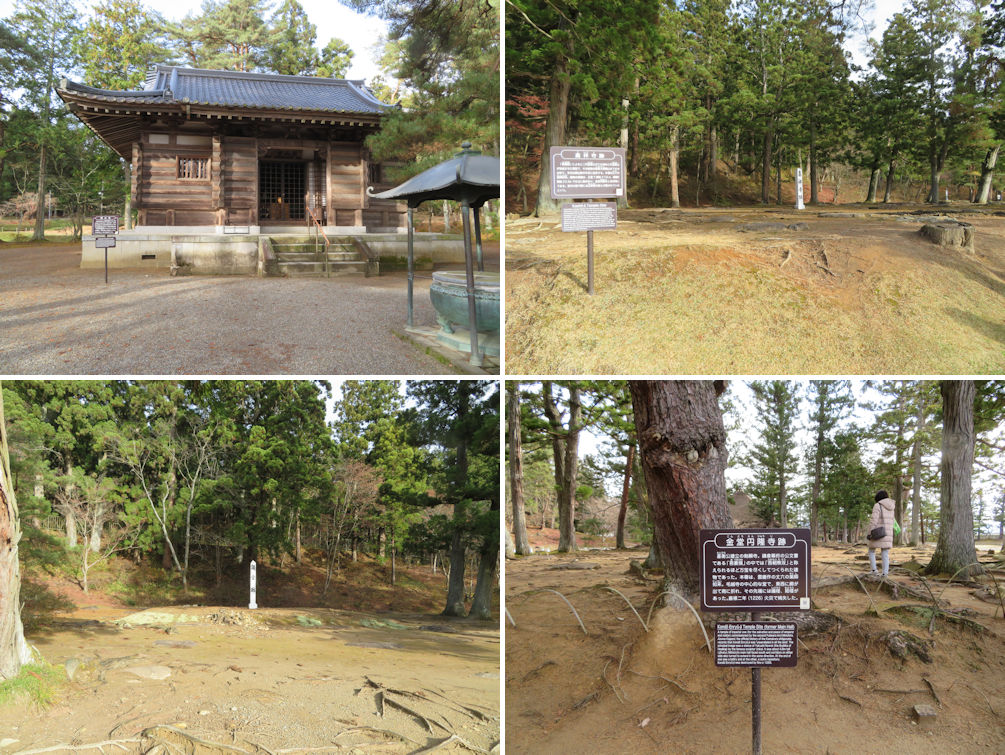
The Kaizando, commemorating the founder of Motsu-ji, Ennin houses a wooden statue of Ennin and a portrait of the three Fujiwara lords, Kiyohira, Motohira and Hidehira (upper left). The foundation of Kasho-ji Temple which sat to the left of the main temple building, and understood to date back to the 9th century (upper right). The remains of Kondo Enryu-ji, which served as the main temple building and housed a 4.8 meters tall statue of Yakushi Nyorai (lower left). An English translation is provided for most descriptions (lower right).
I tried to keep viewing the pond as we moved clockwise. According to the English explanation provided by the Japan Tourism Agency, “The Motsuji Temple Garden was constructed according to Heian period (794–1185) principles of garden design that focused on the use of gardens to replicate larger natural landscapes in miniature form. The garden’s central pond, Oizumigaike, represents the sea, with additional features that emulate a beach, a rugged coastline, and a stream that flows from the mountains to the sea. Large rock formations on the southwest shore of the pond (tsukiyama) recreate the rugged coast of Japan, while a peninsula along the eastern edge (suhama) simulates a coastal promontory that changes shape with the ebb and flow of the lake. Additional rock formations, called dejima ishigumi, line the southeast shore. Nearby, within the pond, another rock formation creates the impression of a coastal shoreline. Its focal point, the Ikenaka Tateishi, is a single stone that rises 2.5 meters above the surface of the pond”. Our guide provided a similar explanation as we traveled around the pond.
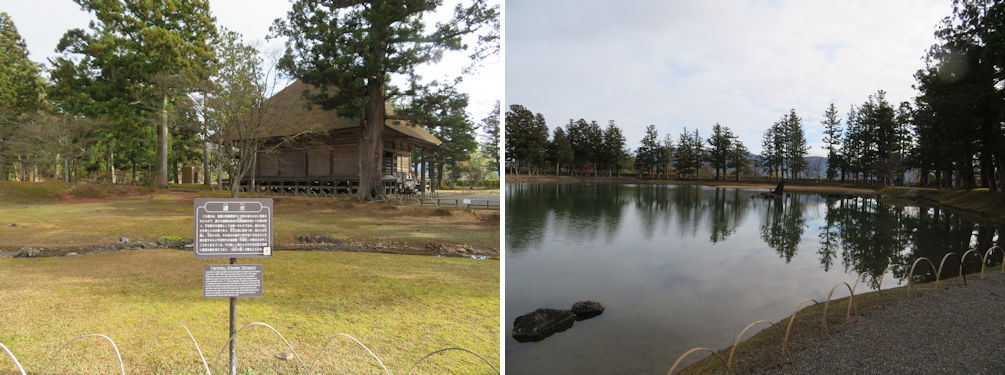
The river stream flowing into the pond was excavated in its original condition (left). the beach and single stone in front (right).
We next came to a wooden building, the Jogyodo (Circumambulation Hall), reconstructed in 1732 which is an active building, housing a statue of a crowned Amida Nyorai (Amitabha). At the eastern edge of the pond, you can catch a glimpse of Kanjizaio-in Ato, that I explained before.
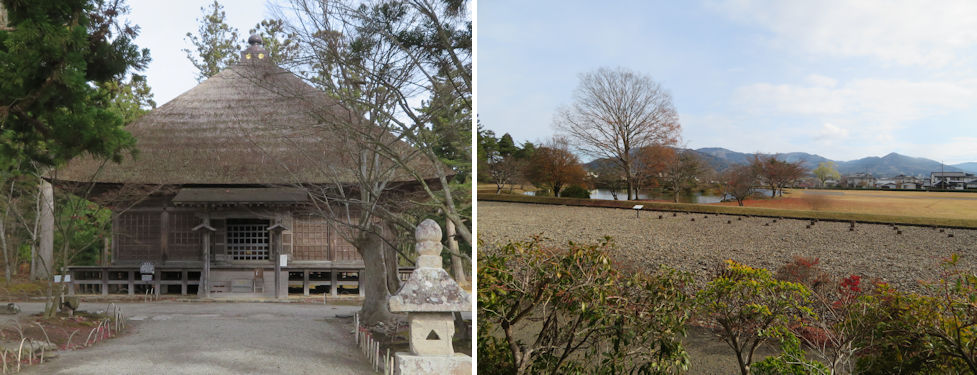
The Jogyodo (Circumambulation Hall), reconstructed in 1732 is an active building (left). A glimpse of Kanjizaio-in Ato, observed from the eastern perimeter of Motsu-ji Temple (right).
We left the Motsu-ji car park for Chuson-ji. It is only a couple of minutes’ drive from Motsu-ji, but would guess that it will take about a quarter of an hour by foot. I’ve already provided a brief explanation of Chuson-ji. Here I will add that the temple complex of Chusonji is located on a hill called Kanzan Hills, with an altitude of approximately 150 meters, and so the proper name of the temple is Kanzan Chuson-ji. Buddhist temples were traditionally located in hills and mountains, and hence temple names are usually crowned with a name of a mountain or hill. This is the reason many entrance gates to Buddhist temples are called Sanmon (mountain gate). We parked at the free parking space located at the bottom of the hill. It is quite a steep and long walk to the temple complex area. This was in early December, and although it was a sunny day, there was some snow left in shaded areas. There were far more visitors than Motsu-ji, most likely because of the prominence of Konjikido, the golden temple.
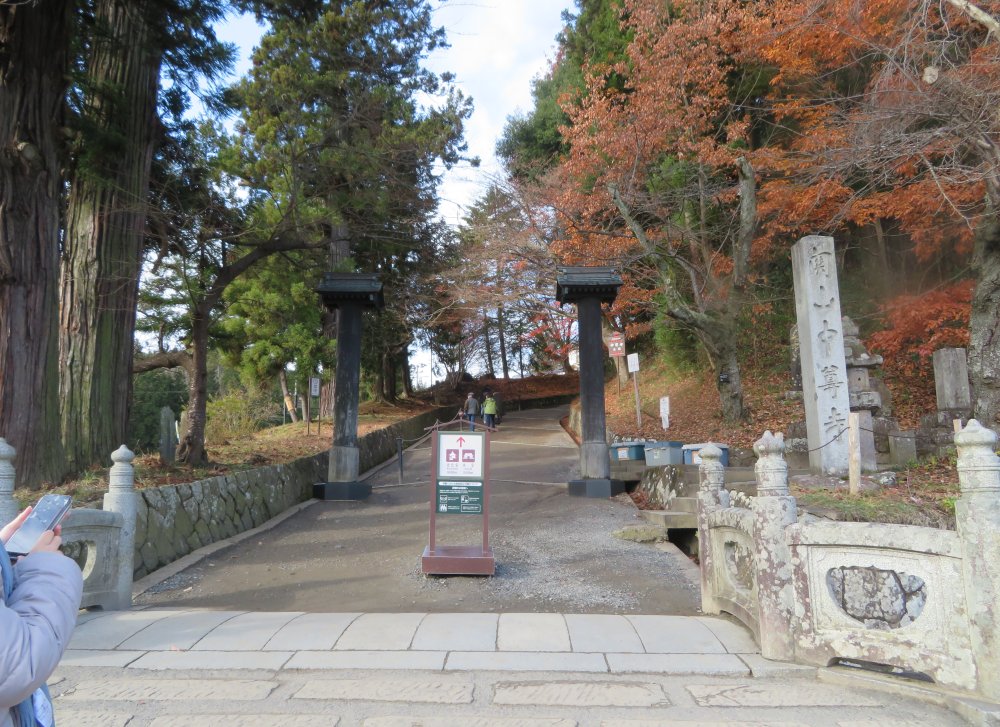
Entrance to Chuson-ji at the bottom of the hill. The pillar on the right says Kanzan Chuson-ji. From there it is quite a steep and long walk to the temple complex area.
Just before the climb ends, there is a lane stemming left from the main temple approach and leading to a wooden building reconstructed in 1827. The building is called Benkei-do, to commemorate Benkei, a warrior monk who was loyal to his master Yoritsune Minamoto (younger brother of Yoritomo Minamoto, who became the first samurai shogun) to the end. Yoritomo, unhappy with the popularity of Yoritsune who was the main hero in the feud with the Heiji clan, accused Yoritsune of mutiny, and forced Yasuhira Fujiwara (to whom Yoshitsune had fled to) to assassinate Yoshitsune in Hiraizumi. Yoshitsune was characterized as a tragic hero, and became a popular theatre character.

Wooden building called Benkei-do, to commemorate Benkei, a warrior monk who was loyal to his master Yoritsune Minamoto to the end. Yoshitsune was characterized as a tragic hero, and became a popular theatre character together with Benkei.
We returned to the main approach, went past the many temple buildings to reach the Sankozo Museum displaying more than 3,000 National Treasures and Important Cultural Properties, including Buddhist statues, sutras, and the burial items of the Fujiwara lords. The admission fee is 800 yen, which includes admission to the Konjikido. The amazing collection of treasures from the late Heian era is certainly worth spending some time.
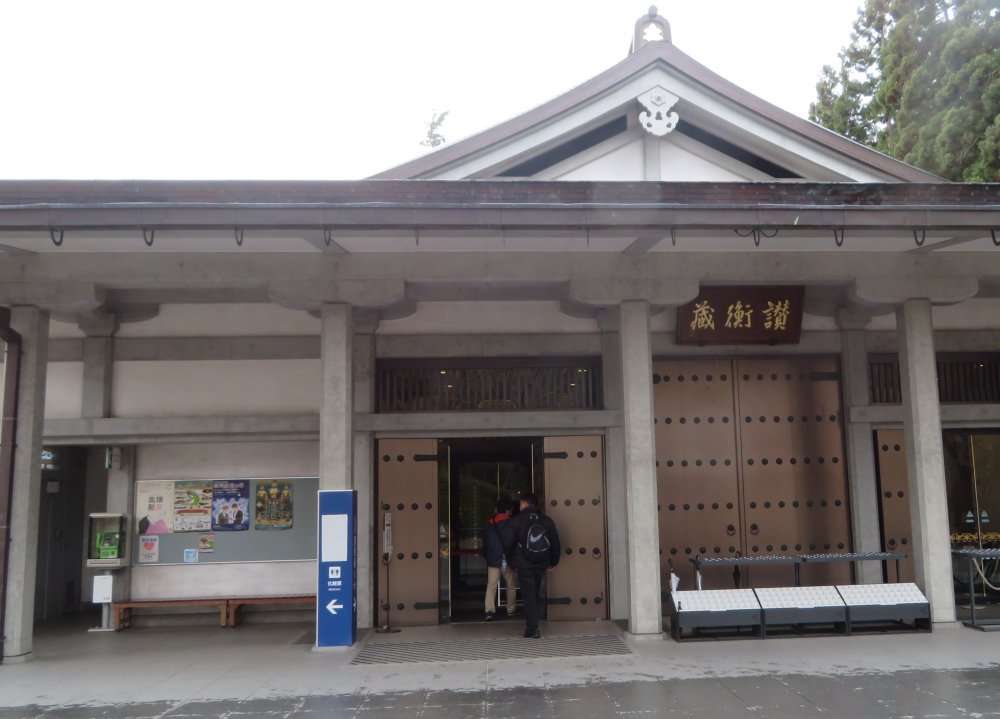
The Sankozo Museum displaying more than 3,000 National Treasures and Important Cultural Properties, including Buddhist statues, sutras, and the burial items of the Fujiwara lords.
Following the visit to the museum, we went to the admission gate of an adjacent secluded area housing the Konjikido, the Sutra Repository, and the former Konjikidō Shelter Hall. As per the explanation on Chuson-ji’s homepage (https://www.chusonji.or.jp/language_en/index.html), “The Konjikidō, completed in 1124, is the only 12th century structure to survive in its original form at Chūson-ji. This small hall is dedicated to Amida Nyorai (the Buddha of Infinite Light) and apart from the roof, is covered with gold leaf both inside and out”. The Konjikido is sheltered by a sheath building built in 1963, replacing the former sheath building.
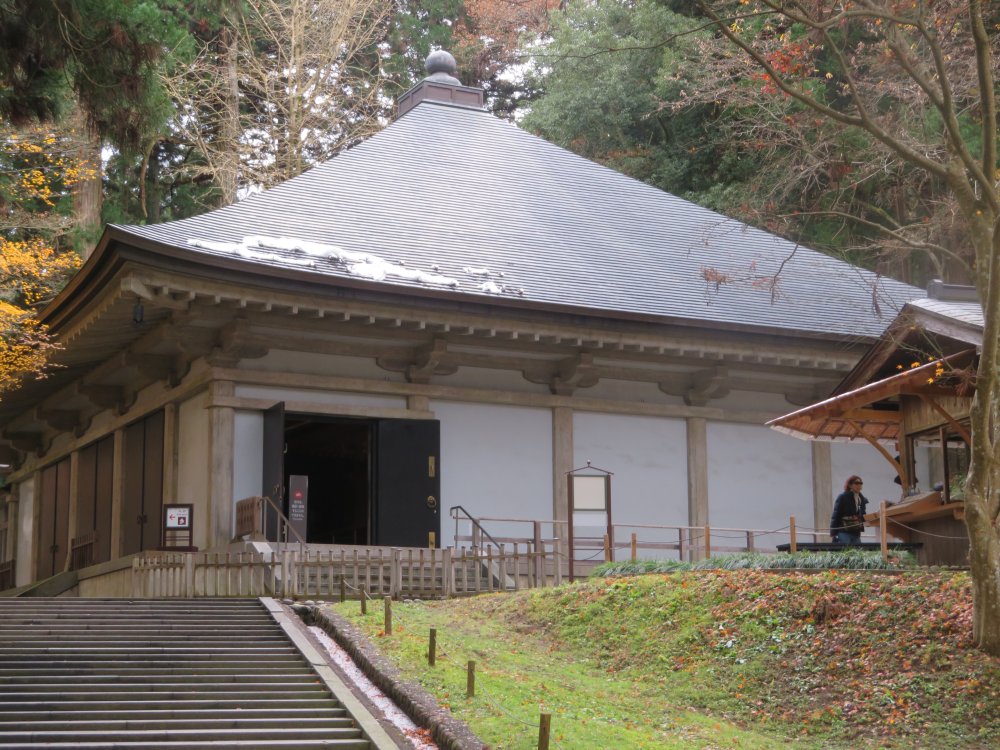
The Konjikido is sheltered by a sheath building built in 1963, replacing the former sheath building. Completed in 1124, it is the only 12th century structure to survive in its original form at Chuson-ji. Photography is not allowed inside. Please refer to the picture above extracted from Hiraizumi Town's website.
Next to the Konjikido is the Kyozo (Sutra Repository), built around the 13th century to store the Chuson-ji Sutras. According to the description of the building provided by Hiraizumi Town (https://hiraizumi.or.jp/joudo/asset/index.html), the "Chusonji-kyo" sutras were a complete set (about 4,500 parchments) of Buddhist scriptures written in alternating rows of gold and silver characters on indigo paper. Most of the parchments were confiscated in the 16th century and the majority transferred to Kongoubuji Temple, the head temple of the Shingon sect in Wakayama Prefecture (Chuson-ji belongs to the Tendai sect, as it was founded by the third head priest of the Tendai sect, Ennin).
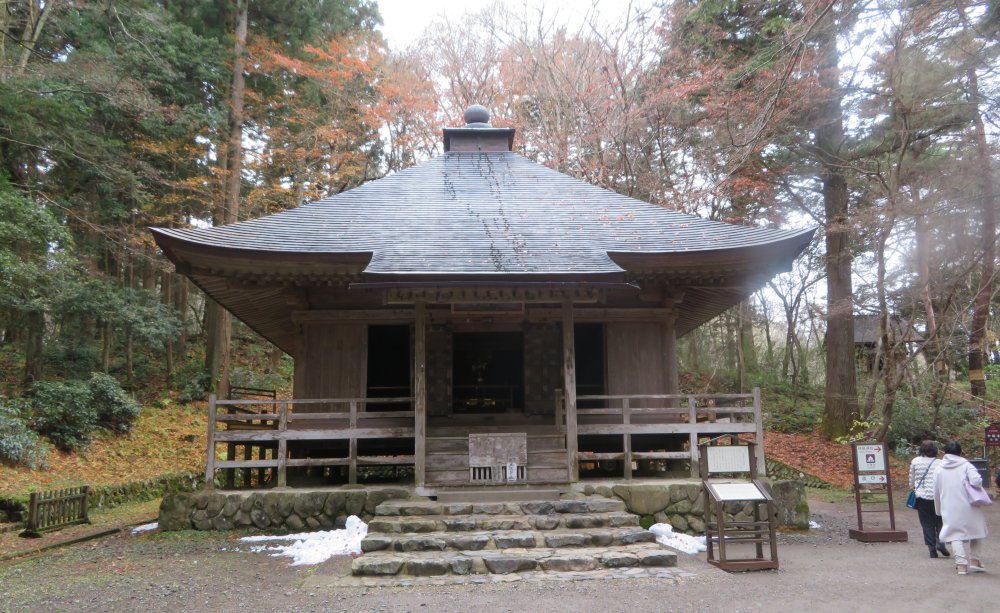
Next to the Konjikido is the Kyozo (Sutra Repository), built around the 13th century to store the Chuson-ji Sutras.
The last building in the secluded area was the Former Sheath Building that protected the Konjikido from wind, rain and snow for nearly seven centuries before it was replaced by the current sheath building in 1963. You can enter the impressive building to view its construction.
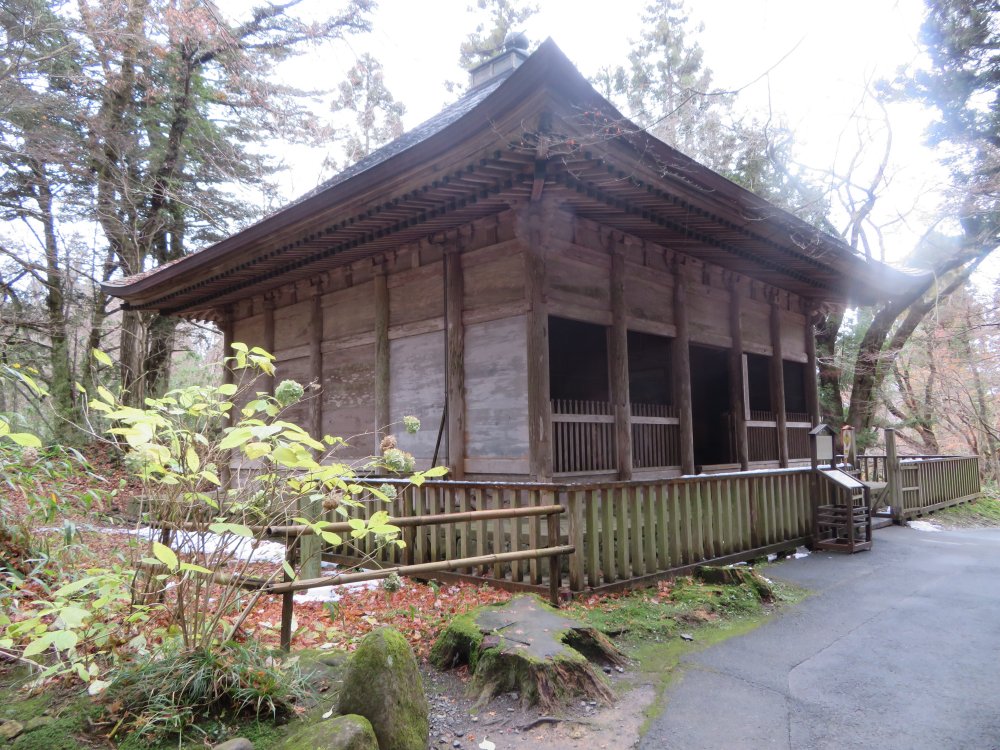
The Former Sheath Building. The description at the front of the building tells that the building is believed to have been completed by the 16th century following additions and modification from the 14th century.
Our guide next showed us to Hakusan Shinto Shrine, also at the top plateau of the hill. It isn’t at all strange to find a Shinto Shrine adjacent to a Buddhist temple. In fact Hakusan Shinto Shrine tells us that it was Ennin, the founder of Chuson-ji himself, that invited the deity of Hakusan Shinto Shrine in Fukui Prefecture to protect Chuson-ji. It is a classic example of how Buddhist priests founded new temples to spread the religion in harmony with the local peoples’ Shinto tradition. The shrine has a Noh theatre reconstructed in 1853. The Noh was and continues to be performed by monks of Chuson-ji.
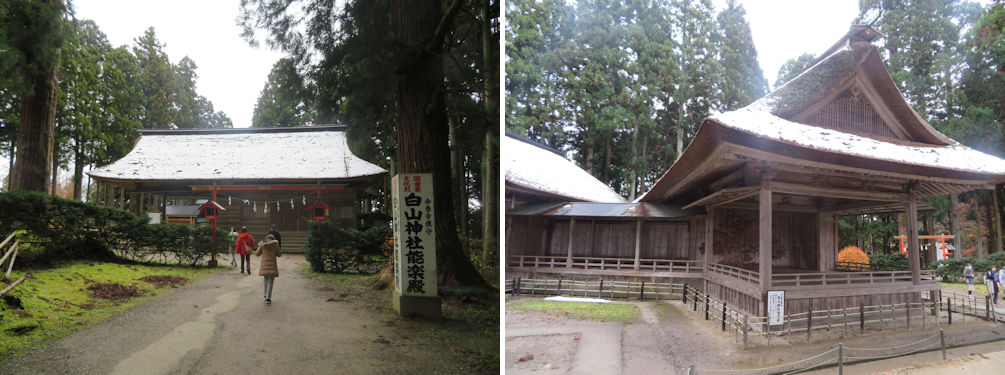
The entrance to Hakusan Shinto Shrine. The sign on the right says, "Important National Cultural Heritage: Protector of Chuson-ji, Hakusan Shinto Shrine Noh Theatre (left). The Noh theatre (right).
On our way back we went past many temple buildings. One of particular interest to me was the Mine Yakushidō. The main statue worshipped here is a Yakushi Nyorai who heals all illness, in this case all eye wounds. Our last visit at Chusonji was the Hondo (main temple building). It is a grand building reconstructed in 1909, where the main rituals are performed. Here, we thanked and parted with our guide.
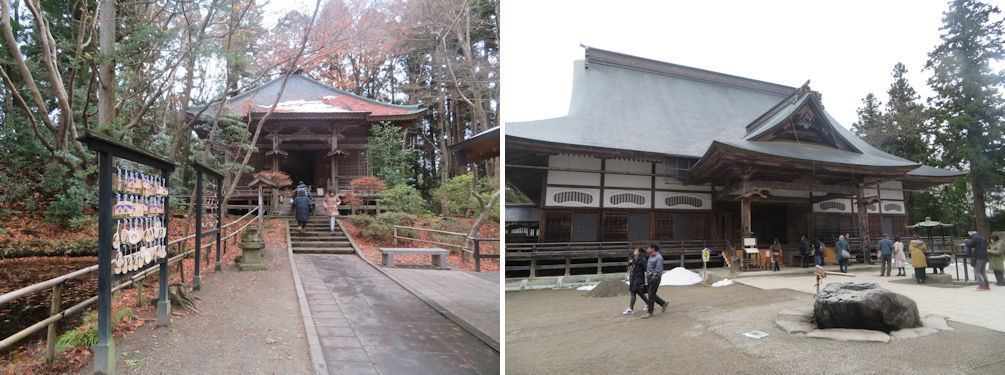
The Mine Yakushido to pray for cure of eye wounds (left). The Hondo, the grand main temple building reconstructed in 1909 (right).
We went back to the car park at the bottom of the hill to visit the Takadachi Gikei-do. I’m sure this sounds like mumbo jumbo, but allow me to shed some light. Takadachi is the name of the residence the Fujiwara Family provided to Yoshitsune Minamoto, the tragic hero, when he fled to Hiraizumi to seek protection from his elder brother, Yoritomo Minamoto. It was here that Yasuhira Fujiwara, the last of the Tohoku Fujiwara Family, succumbing to Yoritomo’s pressure, attacked Yoshitsune, causing him and his family to commit suicide. The admission office was closed for the winter period, but we could still go up to the Yoshitsune-do, commemorating Yoshitsune built by order of the 4th feudal lord of Sendai, Tsunamura Date. I will explain in more detail about the Date Family in the article on Sendai.
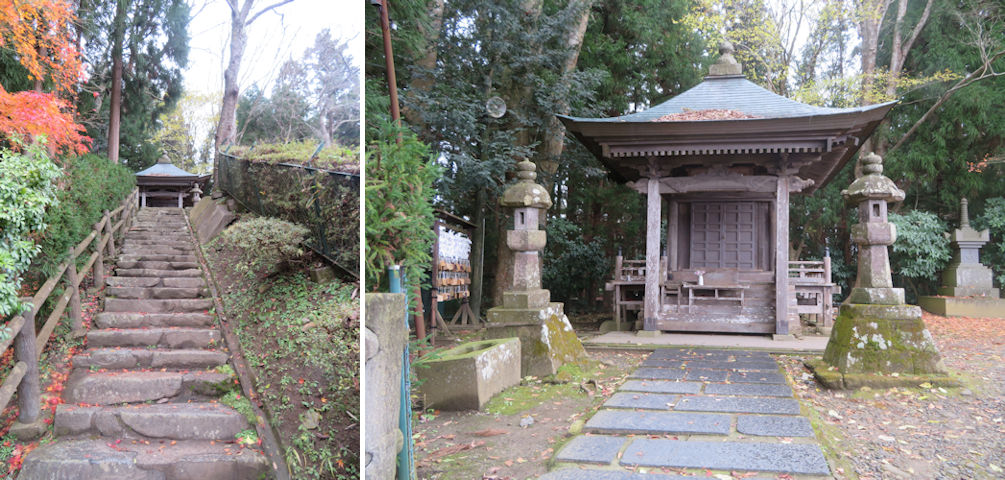
The steps leading up to the Yoshitsune-do (left) and the Yoshitsune-do (right). Takadachi Gikei-do was built on the eastern side of a hill overlooking Kitakami River.
On our way south to Sendai, I caught sight of another large pond on my right. This was the Muryoko-in Temple Ruins that I explained above. The reconstruction work that commenced in 2012 seemed to be still ongoing, although nearing completion, I guess. An Amida-do originally stood on the other (western) side of the pond, with the sacred mountain Kinkeisan behind. The Pure Land was believed to be in the west, so the structure of this paradise garden is based precisely on this principle. It must be a very impressive view at sunset. Perhaps that was one image that helped create Marco Polo’s image of the Golden Land of Japan that he had heard about but never visited. The 12th to 13th century that Marco Polo lived was not long after the heydays of the Fujiwara Family in Hiraizumi. As I had expected, my visit to Hiraizumi was most rewarding, and highly recommendable to overseas visitors, albeit it requires some pre-study and focus points to really appreciate Hiraizumi’s heritage.
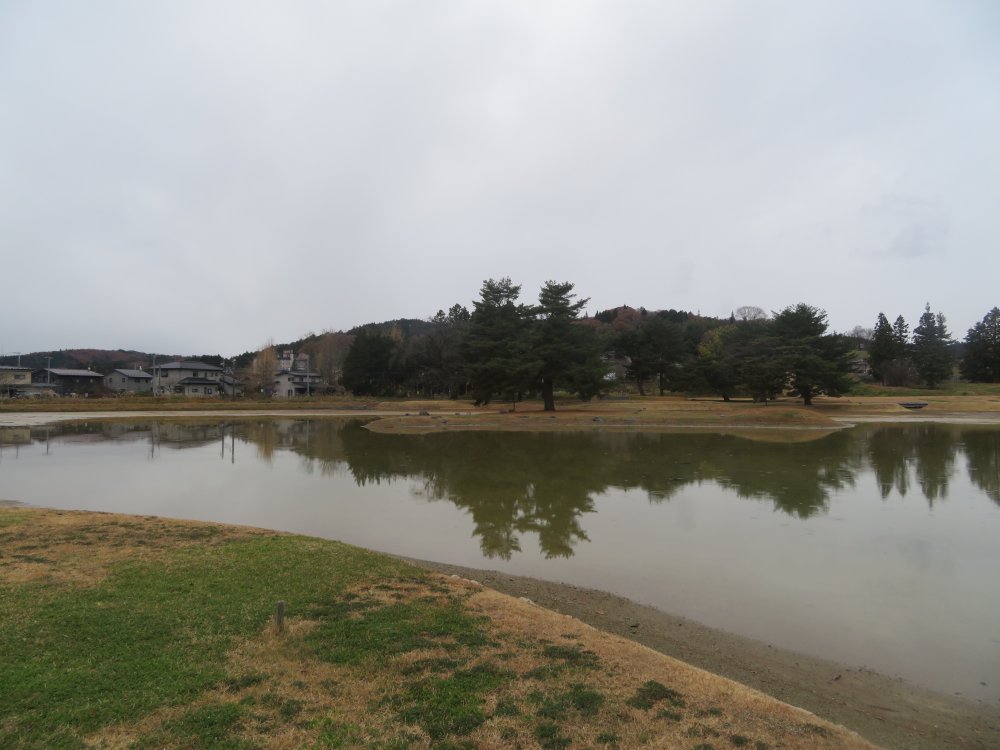
The Muryoko-in Temple Ruins. An Amida-do temple building originally stood on the other (western) side of the pond, with the sacred mountain Kinkeisan behind. The Pure Land was believed to be in the west, so the structure of this paradise garden is based precisely on this principle.